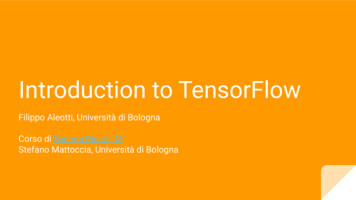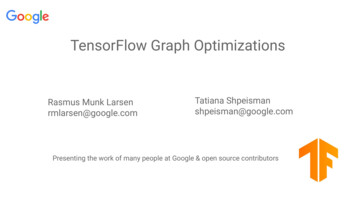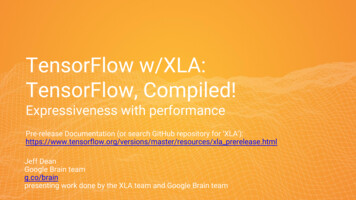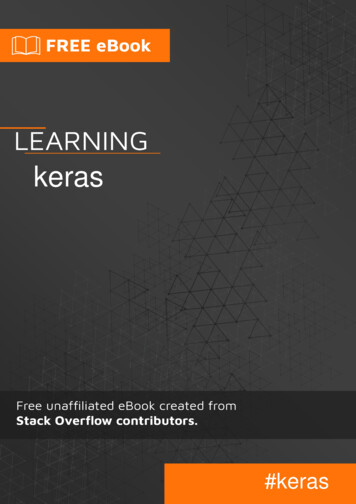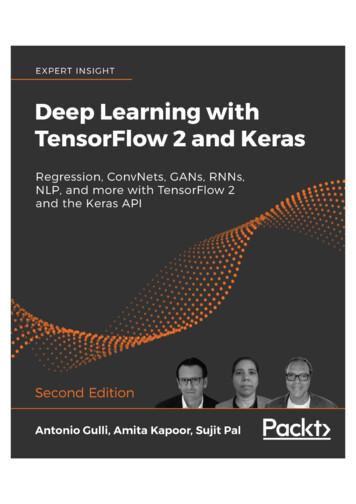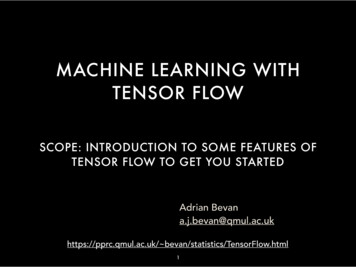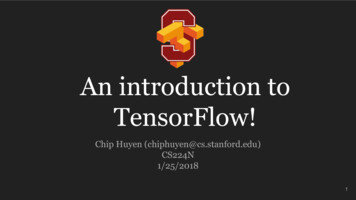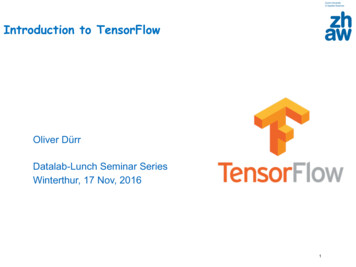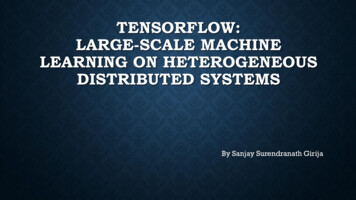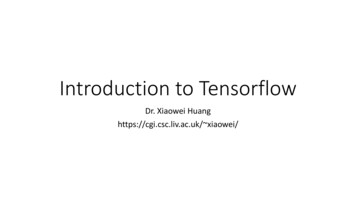
Transcription
Introduction to TensorflowDr. Xiaowei Huanghttps://cgi.csc.liv.ac.uk/ xiaowei/
Up to now, Overview of Machine Learning Traditional Machine Learning Algorithms Deep Learning IntroductionFunctional view & featuresForward and backward computationCNNs
Today’s topic Where learning is used? Introduction to Tensorflow Example: Linear Regression in TensorFlow
Perception-Cognition-Action Loop
PerceptionVisual RecognitionVoice RecognitionTeaching content:traditional learning,deep learning
Teaching content:Probabilistic graphical modelsCognition by Probabilistic InferenceQ. how to automaticallyinfer the disease (e.g.,lung disease, cold, etc)from the symptoms (e.g.,smokes, shortness ofbreath, chest pain,cough, fever, etc)?Note: Symptoms obtainedfrom perception.
Action by PlanningTeaching content:in other modules, e.g., COMP111,COMP222After cognition, we may usethe obtained knowledge toreact to the environmentQ: in the factory floor asshown in the left diagram,how many robots is neededto patrol the area? and howto plan their activities?
What’s left?action, atasetknowledgeperceptionstructural representation, e.g.,Probabilistic graphical model
Introduction to Tensorflow
Deep-Learning Package Design Choices Model specification: Configuration file (e.g. Caffe, DistBelief, CNTK) versus programmatic generation (e.g. Torch, Theano, Tensorflow)I used these two For programmatic models, choice of high-level language: Lua (Torch) vs. Python (Theano, Tensorflow) vs others. We chose to work with python because of rich community and libraryinfrastructure.
What is TensorFlow? TensorFlow is a deep learning library open-sourced by Google. But what does it actually do? TensorFlow provides primitives for defining functions on tensors andautomatically computing their derivatives.
But what’s a Tensor? Formally, tensors are multilinear maps from vector spaces to the realnumbers (V vector space, and V* dual space) Common to have fixed basis, so a tensor can be represented as amultidimensional array of numbers.
TensorFlow vs. Numpy Few people make this comparison, but TensorFlow and Numpy arequite similar. (Both are N-d array libraries!) Numpy has Ndarray support, but doesn’t offer methods to createtensor functions and automatically compute derivatives ( no GPUsupport).
Simple Numpy Recap
Repeat in TensorFlow
Numpy to TensorFlow Dictionary
TensorFlow requires explicit evaluation!
TensorFlow Session Object (1) “A Session object encapsulates the environment in which Tensorobjects are evaluated”
TensorFlow Session Object (2) tf.InteractiveSession() is just convenient syntactic sugar for keeping adefault session open in ipython. sess.run(c) is an example of a TensorFlow Fetch. Will say more on thissoon
Tensorflow Computation Graph “TensorFlow programs are usually structured into a construction phase, that assembles a graph, and an execution phase that uses a session to execute ops in the graph.” All computations add nodes to global default graph
TensorFlow Variables (1) “When you train a model you use variables to hold and updateparameters. Variables are in-memory buffers containing tensors” All tensors we’ve used previously have been constant tensors, notvariables
TensorFlow Variables (2)
TensorFlow Variables (3) TensorFlow variables must be initialized before they have values!Contrast with constant tensors
Updating Variable State
Fetching Variable State (1)
Fetching Variable State (2)
Inputting Data All previous examples have manually defined tensors. How can weinput external data into TensorFlow? Simple solution: Import from Numpy:
Placeholders and Feed Dictionaries (1) Inputting data with tf.convert to tensor() is convenient, but doesn’tscale. Use tf.placeholder variables (dummy nodes that provide entry pointsfor data to computational graph). A feed dict is a python dictionary mapping from tf. placeholder vars(or their names) to data (numpy arrays, lists, etc.).
Placeholders and Feed Dictionaries (2)
Placeholders and Feed Dictionaries (3)
Variable Scope (1) Complicated TensorFlow models can have hundreds of variables. tf.variable scope() provides simple name-spacing to avoid clashes. tf.get variable() creates/accesses variables from within a variable scope.
Variable Scope (2) Variable scope is a simple type of namespacing that adds prefixes tovariable names within scope
Variable Scope (3) Variable scopes control variable (re)use You’ll need to use reuse variables() to implement RNNs in homework
Ex: Linear Regression in TensorFlow (1)
Ex: Linear Regression in TensorFlow (2)
Ex: Linear Regression in TensorFlow (3)
Ex: Linear Regression in TensorFlow (4)
Ex: Linear Regression in TensorFlow (4)
Ex: Linear Regression in TensorFlow (6)
Concept: Auto-Differentiation Linear regression example computed L2 loss for a linear regressionsystem. How can we fit model to data? tf.train.Optimizer creates an optimizer. tf.train.Optimizer.minimize(loss, var list) adds optimization operation tocomputation graph. Automatic differentiation computes gradients without user input!
TensorFlow Gradient Computation TensorFlow nodes in computation graph have attached gradientoperations. Use backpropagation (using node-specific gradient ops) to computerequired gradients for all variables in graph.
TensorBoard TensorFlow has some neat built-in visualization tools (TensorBoard). We won’t use TensorBoard for assignments, but encourage you tocheck it out for your projects.
What is TensorFlow? TensorFlow is a deep learning library open-sourced by Google. But what does it actually do? TensorFlow provides primitives for defining functions
